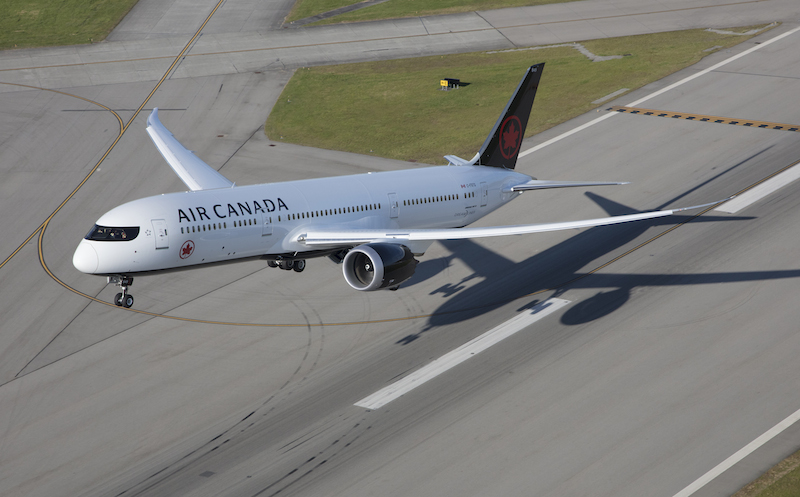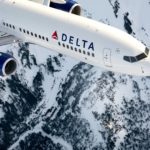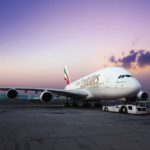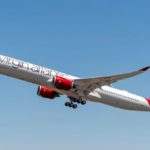
- Air Canada Q3 EBITDA grew 9% to USD 1.47 billion compared to USD 1.35 billion in the same period of 2018.
- It brought home operating income worth USD 956 million, USD 33 million more than the comparable period last year.
- Calin Rovinescu, President and Chief Executive Officer of Air Canada said: “I am pleased to report an excellent third quarter for Air Canada, in which we generated record operating revenues of close to USD 5.6 billion and reached record liquidity of nearly USD 7.4 billion. Impressive as such strong results are on their own, they are even more meaningful given that we achieved them despite the serious disruption to our operations and to our cost structure created by the Boeing 737 MAX grounding. Our record performance is a testament to the resourcefulness, skill and dedication of the entire Air Canada team, and I applaud and thank them for their hard work taking care of our customers since the Boeing 737 MAX grounding occurred.”
- Air Canada was recognised on the Toronto Stock Exchange’s inaugural TSX30 – a new programme that includes Canada’s top performing stocks on the exchange over three years.
PRESS RELEASE
Air Canada today reported third quarter 2019 EBITDA(1) (earnings before interest, taxes, depreciation, amortization and impairment) of $1.472 billion compared to third quarter 2018 EBITDA of $1.351 billion, an increase of $121 million or 9 per cent. The airline reported third quarter 2019 operating income of $956 million compared to third quarter 2018 operating income of $923 million.
“I am pleased to report an excellent third quarter for Air Canada, in which we generated record operating revenues of close to $5.6 billion and reached record liquidity of nearly $7.4 billion. Impressive as such strong results are on their own, they are even more meaningful given that we achieved them despite the serious disruption to our operations and to our cost structure created by the Boeing 737 MAX grounding. Our record performance is a testament to the resourcefulness, skill and dedication of the entire Air Canada team, and I applaud and thank them for their hard work taking care of our customers since the Boeing 737 MAX grounding occurred,” said Calin Rovinescu, President and Chief Executive Officer of Air Canada.
“During the quarter, our airline delivered on key metrics. This included EBITDA of $1.472 billion, an increase of 9 per cent from the previous year, higher operating income, and improved yields. Our leverage ratio(1) was 0.8 at the quarter’s end, a decrease of 50 per cent from December 31, 2018. The significant progress we have made on our balance sheet was recognized in the third quarter and, earlier this year, by upgrades from major debt rating agencies, advancing us to one level below our goal of investment grade status.
“Through great effort and teamwork, we have successfully managed through the extremely challenging 737 MAX grounding for nearly eight months now, most recently adjusting our schedule to remove the aircraft until February 14, 2020 and wet leasing two Airbus A330 aircraft to ensure we have sufficient capacity this winter. However, the removal of a scheduled 36 737 MAX aircraft during our peak summer season exacted a toll from a financial, route, product, and human resources perspective and the grounding is preventing us from realizing our full potential,” said Mr. Rovinescu.
“I nonetheless remain confident that if regulators unground the aircraft near-term, our on-going transformation will quickly regain its previous trajectory. For this reason, we have chosen at this time not to adjust our long-term financial targets presented at our last Investor Day. Much of my confidence flows from the professionalism our employees have demonstrated throughout this year since the aircraft was grounded, as well as the strong loyalty shown by our customers, and I thank both groups for their commitment to and support of Air Canada.
“As well, we were extremely pleased to see that during the third quarter Transat A.T. shareholders approved the definitive acquisition agreement with Air Canada, by a vote of nearly 95 per cent. This overwhelmingly favourable vote underscores the numerous benefits for all stakeholders from the proposed merger, which now remains subject to applicable regulatory approvals and customary conditions.”
Third Quarter Income Statement Highlights
Air Canada began consolidating Aeroplan’s financial results on the date of the acquisition of Aeroplan, January 10, 2019. Air Canada adopted accounting standard IFRS 16 – Leases effective January 1, 2019 and restated 2018 amounts (including for period-over-period comparisons).
On a capacity reduction of 2.1 per cent, record third quarter system passenger revenues of $5.164 billion increased $146 million or 2.9 per cent from the same quarter in 2018. The increase in system passenger revenues was driven by a yield improvement of 4.8 per cent, partly offset by a traffic decrease of 1.8 per cent. System yield in the third quarter of 2019 improved due to the constrained capacity resulting from the grounding of the Boeing 737 MAX aircraft as well as a generally improved pricing environment, mainly in North America. The yield increases also included additional revenues from Aeroplan flight redemptions and other revenues subsequent to the Aeroplan acquisition on January 10, 2019.
In the third quarter of 2019, operating expenses of $4.597 billion increased $105 million or 2 per cent from the third quarter of 2018. Air Canada’s cost per available seat mile (CASM) increased 4.5 per cent from the third quarter of 2018. The airline’s adjusted CASM(1) increased 9.3 per cent over the same quarter in 2018. These increases reflected, in large part, the impact of the Boeing 737 MAX aircraft grounding which resulted in a system ASM decline of 2.1 per cent versus planned system ASM growth of approximately 3 per cent, in addition to creating higher costs associated with replacement aircraft, and on-going operating expenses, including depreciation and pilot wages, that continued to be incurred in relation to the Boeing 737 MAX aircraft despite their grounding. Given that the Aeroplan loyalty business was not consolidated in Air Canada’s financial results in 2018, for a more meaningful comparison of the cost performance of the on-going airline business, Air Canada’s adjusted CASM for the third quarter and first nine months of 2019 excludes the operating expenses of Aeroplan.
Air Canada’s third quarter EBITDA of $1.472 billion was 9 per cent higher than the third quarter of 2018, and better than the increase of approximately 5 per cent projected in Air Canada’s news release dated July 30, 2019. This better than expected EBITDA performance was primarily driven by a lower fuel price per litre than what Air Canada had previously assumed in its guidance.
Third quarter 2019 net income amounted to $636 million or $2.35 per diluted share compared to third quarter 2018 net income of $702 million or $2.55 per diluted share. The third quarter of 2019 included foreign exchange gains of $27 million while the third quarter of 2018 included foreign exchange gains of $145 million. Air Canada reported adjusted net income(1) of $613 million or $2.27 per diluted share in the third quarter of 2019 compared to adjusted net income of $580 million or $2.10 per diluted share in the third quarter of 2018.
Financial and Capital Management Highlights
At September 30, 2019, unrestricted liquidity (cash, cash equivalents and short and long-term investments, and undrawn lines of credit) amounted to a record $7.355 billion (September 30, 2018 – $5.309 billion).
At September 30, 2019, net debt of $2.999 billion decreased $2.215 billion from December 31, 2018, reflecting an increase in cash, cash equivalents and short and long-term investment balances of $1.654 billion and a decrease in long-term debt and lease liabilities of $561 million. At September 30, 2019, Air Canada’s leverage ratio was 0.8 versus a ratio of 1.6 at December 31, 2018.
Net cash flows from operating activities of $834 million increased $284 million from the third quarter of 2018. In the third quarter of 2019, free cash flow(1) of $533 million decreased $64 million from the third quarter of 2018. In the third quarter of 2018, Air Canada received proceeds of $293 million from the sale and leaseback of 25 Embraer aircraft while no such proceeds were received in the third quarter of 2019. In the third quarter of 2019, the increase in cash flows from operating activities over the third quarter of 2018 was partly offset by an increase in capital expenditures of $55 million. Excess cash amounted to $2.683 billion at September 30, 2019. Refer to section 6.1 “Liquidity” of Air Canada’s Third Quarter 2019 MD&A for additional information on excess cash.
For the 12 months ended September 30, 2019, return on invested capital (ROIC(1)) was 15.5 per cent, significantly higher than Air Canada’s weighted average cost of capital of 7.2 per cent.
Normal Course Issuer Bid
In the third quarter of 2019, Air Canada purchased, for cancellation, a total of 2,111,800 shares at an average cost of $43.15 per share for aggregate consideration of $91 million (6,426,287 shares at an average cost of $38.87 per share for aggregate consideration of $250 million for the first nine months of 2019). At September 30, 2019, a total of 20,533,751 shares remained available for repurchase under Air Canada’s issuer bid which is scheduled to expire May 30, 2020.
Full Year 2019 Outlook and 2020-21 Investor Day Targets
As indicated in its October 16, 2019 news release, Air Canada removed Boeing 737 MAX flying from its schedule until February 14, 2020. Final decisions on returning the Boeing 737 MAX aircraft to service will be based on Air Canada’s safety assessment following the lifting of government safety notices and approval by regulatory authorities.
Air Canada’s projected capital expenditures, discussed in section 6.6 of Air Canada’s Third Quarter 2019 Management’s Discussion and Analysis of Results, reflect Air Canada’s assumption that the remaining 12 Boeing 737 MAX aircraft previously scheduled for delivery 2019 will now be delivered in 2020. Air Canada continues to expect the 14 737 MAX aircraft scheduled for 2020 to be delivered in 2020.
For the full year 2019, Air Canada projects the following:
EBITDA margin (earnings before interest, taxes, depreciation, amortization and impairment, as a percentage of operating revenue) of approximately 19.0 per cent
ROIC of between 15.5 per cent and 16.0 per cent
Free cash flow of between $1.3 billion to $1.5 billion.
Free cash flow for 2019 is being positively impacted by a number of factors, including the deferral of the delivery of 12 Boeing 737 MAX aircraft from 2019 to 2020, lower capital expenditures across many different areas (mainly timing-related), a stronger working capital performance, the impact of aircraft lease extensions which defers the end of lease maintenance obligation, and the favourable impact of higher cash and investment balances on net interest expense.
A leverage ratio not exceeding 1.0 at December 31, 2019 (measured by net debt over trailing 12-month EBITDA)
The financial guidance provided in Air Canada’s news release dated February 28, 2019 for the years 2020 and 2021 with respect to annual EBITDA margin and annual ROIC, as well as the cumulative free cash flow over the 2019-2021 period, remains in place.
Major Assumptions
Assumptions were made by Air Canada in preparing and making forward-looking statements (including EBITDA margin, ROIC and free cash flow guidance referred to above for the years 2020 and 2021).
As part of its assumptions, for 2019, Air Canada assumes:
Modest Canadian GDP growth for the fourth quarter and full year
That the Canadian dollar will trade, on average, at C$1.33 per U.S. dollar in the fourth quarter and full year
That the price of jet fuel will average 77 CAD cents per litre in the fourth quarter and full year
Air Canada’s assumptions as they pertain to the 2020-to-2021 period are provided in Air Canada’s news release dated February 28, 2019. Air Canada’s guidance for 2020 and 2021 also assumes the return to service of the Boeing 737 MAX aircraft in the first quarter of 2020.
It is premature to assess what the impact of Air Canada’s acquisition of Transat A.T. would be, and it is therefore not factored into Air Canada’s guidance.
The outlook provided constitutes forward-looking statements within the meaning of applicable securities laws and is based on a number of assumptions (including those provided above) and subject to a number of risks. Please see the section below entitled “Caution Regarding Forward-Looking Information”.
(1) Non-GAAP Measures
Below is a description of certain non-GAAP measures used by Air Canada in an effort to provide readers with additional information on its financial and operating performance. Such measures are not recognized measures for financial statement presentation under GAAP, do not have standardized meanings, may not be comparable to similar measures presented by other entities and should not be considered a substitute for, or superior to, GAAP results. Readers are advised to review the section entitled Non-GAAP Financial Measures in Air Canada’s Third Quarter 2019 MD&A for a further discussion of such non-GAAP measures and a reconciliation of such measures to Canadian GAAP.
Adjusted net income (loss) and adjusted earnings (loss) per share – diluted are used by Air Canada as a means to assess the overall financial performance of its business without the after-tax effects of foreign exchange gains or losses, net financing expense relating to employee benefits, gains or losses on financial instruments recorded at fair value, gains or losses on sale and leaseback of assets, gains or losses on debt settlements and modifications, gains or losses on disposal of assets, and special items as these items may distort the analysis of certain business trends and render comparative analysis to other airlines less meaningful.
Adjusted pre-tax income (loss) is used by Air Canada to assess the overall pre-tax financial performance of its business without the effects of foreign exchange gains or losses, net financing expense relating to employee benefits, gains or losses on financial instruments recorded at fair value, gains or losses on sale and leaseback of assets, gains or losses on debt settlements and modifications, gains or losses on disposal of assets, and special items as these items may distort the analysis of certain business trends and render comparative analysis to other airlines less meaningful. Air Canada uses adjusted pre-tax income (loss) before interest to determine return on invested capital.
EBITDA (earnings before interest, taxes, depreciation, amortization and impairment) is commonly used in the airline industry and is used by Air Canada as a means to view operating results before interest, taxes, depreciation, amortization and impairment as these costs can vary significantly among airlines due to differences in the way airlines finance their aircraft and other assets. Air Canada excludes special items from EBITDA as these items may distort the analysis of certain business trends and render comparative analysis to other airlines less meaningful.
Adjusted CASM is used by Air Canada as a means to assess the operating and cost performance of its on-going airline business without the effects of aircraft fuel expense, the cost of ground packages at Air Canada Vacations®, the operating costs of Aeroplan, and special items as such expenses may distort the analysis of certain business trends and render comparative analysis to other airlines less meaningful.
In calculating adjusted CASM, aircraft fuel expense is excluded from operating expense results as it fluctuates widely depending on many factors, including international market conditions, geopolitical events, jet fuel refining costs and Canada/U.S. currency exchange rates. Air Canada also incurs expenses related to ground packages at Air Canada Vacations which some airlines, without comparable tour operator businesses, may not incur. In addition, these costs do not generate ASMs and therefore excluding these costs from operating expense results provides for a more meaningful comparison across periods when such costs may vary.
Excluding aircraft fuel expense, the cost of ground packages at Air Canada Vacations and special items from operating expenses generally allows for a more meaningful analysis of Air Canada’s operating expense performance and a more meaningful comparison to that of other airlines.
Following the completion of Air Canada’s acquisition of Aeroplan on January 10, 2019, Air Canada began consolidating Aeroplan’s results. Given that the Aeroplan loyalty business was not consolidated in Air Canada’s financial results in 2018, for a more meaningful comparison of the cost performance of the on-going airline business, Air Canada’s adjusted CASM for 2019 excludes the operating expenses of Aeroplan.
“Leverage ratio” refers to net debt to trailing 12-month EBITDA leverage ratio and is commonly used in the airline industry and is used by Air Canada as a means to measure financial leverage. Leverage ratio is calculated by dividing net debt by trailing 12-month EBITDA (excluding special items). As mentioned above, Air Canada excludes special items from EBITDA results (which are used to determine leverage ratio) as these items may distort the analysis of certain business trends and render comparative analysis to other airlines less meaningful.
Free cash flow is commonly used in the airline industry and is used by Air Canada as an indicator of the financial strength and performance of its business, indicating the amount of cash Air Canada is able to generate from operations and after capital expenditures. Free cash flow is calculated as net cash flows from operating activities minus additions to property, equipment and intangible assets, and is net of proceeds from sale-leaseback transactions. Free cash flow in 2019 also excludes the one-time proceeds related to the Aeroplan acquisition.
Return on invested capital (ROIC) is used by Air Canada as a means to assess the efficiency with which it allocates its capital to generate returns. ROIC is based on adjusted pre-tax income (loss), excluding interest expense. Invested capital includes average year-over-year long-term debt, average year-over-year lease obligations, and average year-over-year shareholders’ equity, net of excess cash. Air Canada defines excess cash as cash not required to operate its core business. Air Canada uses 20 per cent of trailing 12 months operating revenue as its estimate of the minimum cash required to support on-going business operations. This estimate of minimum cash provides adequate coverage for advance ticket sales and to meet Air Canada’s liquidity needs. Air Canada calculates invested capital based on a book value-based method of calculating ROIC, as described above. Refer to the definition of adjusted pre-tax income (loss) for a discussion as to why Air Canada uses adjusted pre-tax income (loss) to assess the overall pre-tax financial performance of its business.




